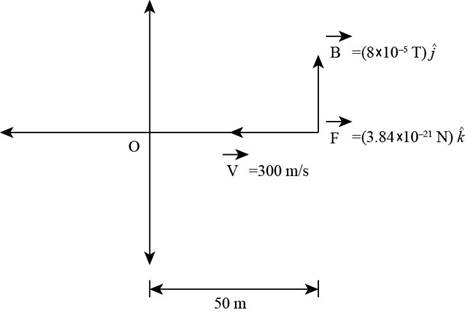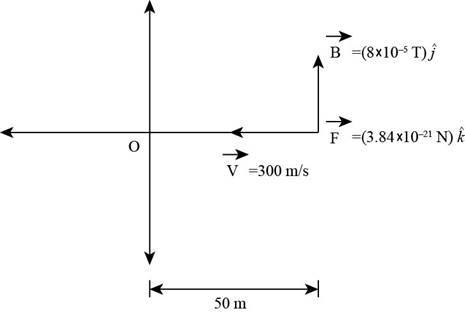
Concept explainers
In a long, .straight, vertical lightning stroke, electrons move downward and positive ions move upward and constitute a current of magnitude 20.0 kA. At a location 50.0 m east of the middle of the stroke, a free electron drifts through the air toward the west with a speed of 300 m/s. (a) Make a sketch showing the various vectors involved. Ignore the effect of the Earth's magnetic field. (b) Find the vector force the lightning stroke exerts on the electron. (c) Find the radius of the electron’s path. (d) Is it a good approximation to model the electron as moving in a uniform field? Explain your answer. (e) If it does not collide with any obstacles, how many revolutions will the electron complete during the 60.0-µs duration of the lightning stroke?
(a)
To draw: The various vectors involved to represent the lightning stroke of the electron and the positive ions.
Answer to Problem 30.16P
The various vectors involved to represent the lightning stroke of the electron and the positive ions as shown below,

Explanation of Solution
Given info: The electrons move downward and the positive ions move upwards. The magnitude of the uniform current is
According to the Ampere’s right hand thumb rule, the index finger represents the direction of the velocity vector
Write the expression for the magnetic field.
Here,
Substitute
Write the expression for the direction of the magnetic field according to the ampere’s law of the magnetic field.
Write the expression for the velocity vector pointed towards the west.
Write the expression for the force vector on the electron,
Here,
Substitute
From the result of the force vector, field vector and velocity vector the as shown below,

Figure (1)
(b)
The vector force lightning stroke exert on the electron.
Answer to Problem 30.16P
The vector force lightning stroke exert on the electron is
Explanation of Solution
Given info: The electrons move downward and the positive ions move upwards. The magnitude of the uniform current is
From the part (a), the vector force on the electron.
Conclusion:
Therefore, the vector force lightning stroke exert on the electron is
(c)
The radius of the electron path.
Answer to Problem 30.16P
The radius of the electron path is
Explanation of Solution
Given info: The electrons move downward and the positive ions move upwards. The magnitude of the uniform current is
Write the expression for the radius of the electron path.
Here,
Substitute
Conclusion:
Therefore, the radius of the electron path is
(d)
Whether it is a good approximation to model the electron as moving in a uniform field.
Answer to Problem 30.16P
The electron was not moving in a uniform field cause of the magnetic field is varies from the location of the lightning stroke.
Explanation of Solution
Given info: The electrons move downward and the positive ions move upwards. The magnitude of the uniform current is
From the figure (1) of the part (a), the magnitude of the magnetic field is varies with the distance of the light stroke towards the positive
Conclusion:
Therefore, the electron was not moving in a uniform field cause of the magnetic field is varies from the location of the lightning stroke.
(e)
The number of the revolutions will the electron complete during the
Answer to Problem 30.16P
The number of the revolutions will the electron complete during
Explanation of Solution
Given info: The electrons move downward and the positive ions move upwards. The magnitude of the uniform current is
From the part (c) the radius of the electron path,
Write the expression for the number of the revolution complete by the electron.
Here,
Substitute
Conclusion:
Therefore, the number of the revolutions will the electron complete during
Want to see more full solutions like this?
Chapter 30 Solutions
Physics for Scientists and Engineers, Technology Update (No access codes included)
- Three long, straight wires are mounted on the vertices of an equilateral triangle as shown in the figure. The wires carry currents of I₁ = 3.50 A, I2 = 5.50 A, and I3 = 8.50 A. Each side of the triangle has a length of 34.0 cm, and the point (A) is located half way between (11) and (12) along one of the sides. Find the magnitude of the magnetic field at point (A). Solve in Teslas (T). I₁arrow_forwardNumber There are four charges, each with a magnitude of 2.38 μC. Two are positive and two are negative. The charges are fixed to the corners of a 0.132-m square, one to a corner, in such a way that the net force on any charge is directed toward the center of the square. Find the magnitude of the net electrostatic force experienced by any charge. ips que Mi Units estic re harrow_forwardTwo long, straight wires are separated by distance, d = 22.0 cm. The wires carry currents of I1 = 7.50 A and I2 = 5.50 A in opposite directions, as shown in the figure. Find the magnitude of the net magnetic field at point (B). Let r₁ = 12.0 cm, r2 = 7.00 cm, and r3 = 13.0 cm. Solve in T. 12 d A √3arrow_forward
- Thank you in advance, image with question is attached below.arrow_forwardQuestion is attached, thank you.arrow_forwardTwo very small spheres are initially neutral and separated by a distance of 0.612 m. Suppose that 4.12 × 1013 electrons are removed from one sphere and placed on the other. (a) What is the magnitude of the electrostatic force that acts on each sphere? (b) Is the force attractive or repulsive?arrow_forward
- Estimate the diameter of the Moon. During a total solar eclipse, the Moon passes in front of the Sun so that during “totality” their apparent sizes match and the Moon blocks light from the Sun shining on the Earth. a) What do you predict the size of the Moon would be if you were to use a pinhole in an aluminum holder, meter stick, and white paper screen to project light from the full Moon through a pinhole onto a screen that is one meter away from the pinhole? b) Describe in detail how you would use this apparatus and your knowledge of pinhole phenomena to estimate the diameter of the Moon. Assume that the distance between the Earth and the Moon is 250,000 miles.arrow_forwardThe following data was collected for a friction experiment in which an object was observed moving at constant speed over a surface. Graph the Applied Force versus the Normal Force and determine the coefficient of friction. Is this value the coefficient of kinetic friction or the coefficient of static friction? Justify your answer. Trial Normal Force Applied Force 1 4.13 1.44 2 6.41 1.68 3 8.94 2.82 4 11.34 3.94 5 13.82 5.05arrow_forward1. Measurements and Linear Regression 1.1 Introduction The objective of this lab assignment is to represent measurement data in graphical form in order to illustrate experimental data and uncertainty visually. It is often convenient to represent experimental data graphically, not only for reporting results but also to compute or measure several physical parameters. For example, consider two physical quantities represented by x and y that are linearly related according to the algebraic relationship, y=mx+b, (1.1) where m is the slope of the line and b is the y-intercept. In order to assess the linearity between y and x, it is convenient to plot these quantities in a y versus x graph, as shown in Figure 1.1. Datapoints Line of regression Figure 1.1: Best fit line example. Once the data points are plotted, it is necessary to draw a "best fit line" or "regression line" that describes the data. A best fit line is a straight line that is the best approximation of the given set of data, and…arrow_forward
- Please help with Statistical Analysis table. These are trials from a Newton's Laws of Motion lab, please help with standard deviation and margin of error. Thanks!arrow_forwardplease solve and answer the question correctly. thank you!!arrow_forwardplease solve and answer the question correctly. thank you!!arrow_forward
 Physics for Scientists and Engineers: Foundations...PhysicsISBN:9781133939146Author:Katz, Debora M.Publisher:Cengage Learning
Physics for Scientists and Engineers: Foundations...PhysicsISBN:9781133939146Author:Katz, Debora M.Publisher:Cengage Learning Physics for Scientists and Engineers, Technology ...PhysicsISBN:9781305116399Author:Raymond A. Serway, John W. JewettPublisher:Cengage Learning
Physics for Scientists and Engineers, Technology ...PhysicsISBN:9781305116399Author:Raymond A. Serway, John W. JewettPublisher:Cengage Learning
 Principles of Physics: A Calculus-Based TextPhysicsISBN:9781133104261Author:Raymond A. Serway, John W. JewettPublisher:Cengage Learning
Principles of Physics: A Calculus-Based TextPhysicsISBN:9781133104261Author:Raymond A. Serway, John W. JewettPublisher:Cengage Learning Glencoe Physics: Principles and Problems, Student...PhysicsISBN:9780078807213Author:Paul W. ZitzewitzPublisher:Glencoe/McGraw-Hill
Glencoe Physics: Principles and Problems, Student...PhysicsISBN:9780078807213Author:Paul W. ZitzewitzPublisher:Glencoe/McGraw-Hill College PhysicsPhysicsISBN:9781305952300Author:Raymond A. Serway, Chris VuillePublisher:Cengage Learning
College PhysicsPhysicsISBN:9781305952300Author:Raymond A. Serway, Chris VuillePublisher:Cengage Learning





